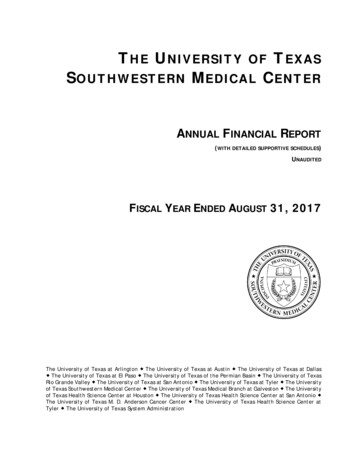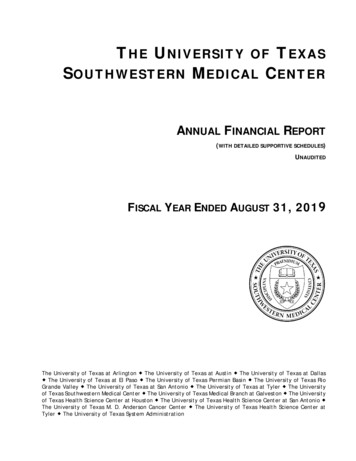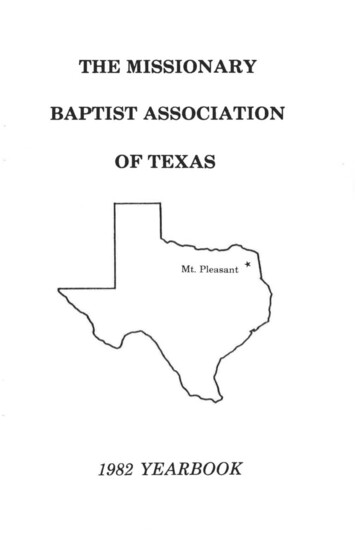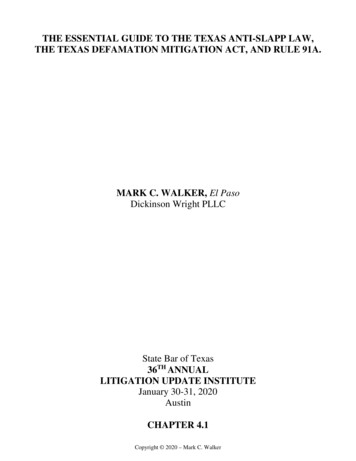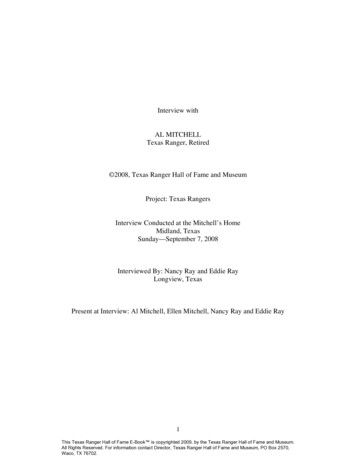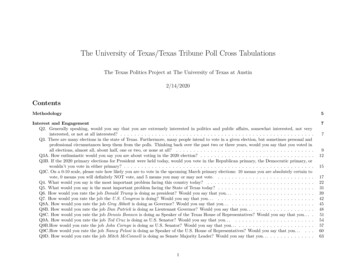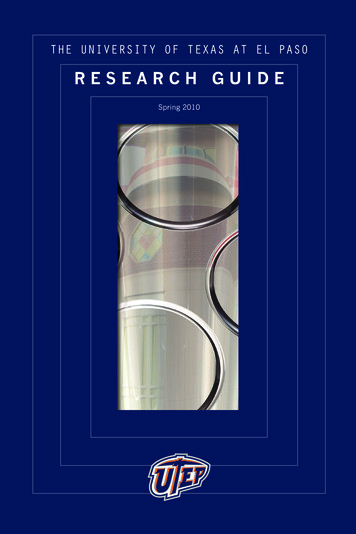
Transcription
The University of Texas at El Pasoresearch guideSpring 2010
INSIDE2UTEP Fast Facts4Overview6About This Guide8Tier One12 Biomedical Engineering16 Biomedical Sciences22 Computational Science24 Defense Research28 Education Innovations36 Environmental Scienceand ResourceManagement40 Geological Sciences44 Health Sciences48 Materials Engineering54 Transportation56 Programs Inspire NewResearchers59 Future Facilities of UTEPResearch Programs60 President, Provost/VicePresident for AcademicAffairs,Vice Presidentfor Research andCollege DeansResearch Guide 1
UTEP Fast FactsThe Texas Higher Education Coordinating Board has designated The University of Texas at El Paso (UTEP) as oneof the state’s seven emerging Tier One universities. Supported by the funding avenues set out by House Bill 51 inJune 2009 and Proposition 4, passed in November 2009, UTEP has embarked on a communitywide campaign toreach Tier One status.In fall 2009, UTEP enrolled a record 21,011 students—the eighth consecutive record fall enrollment. The spring2010 enrollment of 20,198 students also surpassed previous spring semester records.UTEP proudly delivers higher education access and excellence to a 21st century demographic—75 percent of theUniversity’s students are Hispanic, and more than half are the first in their families to attend college.With 60 million in total annual research spending, UTEP ranks second among The University of Texas Systemacademic institutions in federally funded research expenditures after UT Austin, and fourth in the state after UTAustin, Texas A&M University and the University of Houston. UTEP makes the most of its strengths in the areas ofbiomedicine, Hispanic health disparities, border and homeland security, environmental and Earth science, emergingtechnologies, and borderland arts and humanities. The Carnegie Foundation classifies UTEP as a “high researchactivity,” doctorate-granting university.UTEP scientists have received numerous awards of 1 million and more from prestigious research programssponsored by the National Science Foundation, the National Institutes of Health, the Department of Defense, theNational Aeronautics and Space Administration and other public and private agencies.Nestled in the desert foothills of the rugged Franklin Mountains just north of the Rio Grande,The University of Texas at El Paso is a large public urban university serving more than 21,000students in the El Paso/Juárez metropolis of 2.4 million residents on the U.S.-Mexico border.2 The University of Texas at El Paso
UTEP offers 79 bachelor’s degrees, 86 master’s degrees and 16 doctorates—with more in development. UTEP alsooffers cooperative Ph.D. programs in pharmacy and nursing with UT Austin and the UT Health Sciences Center atHouston.UTEP is a key economic force in the Paso del Norte region that includes West Texas, Southern New Mexico andNorthern Mexico. UTEP’s operating budget for FY09-10 is 355 million. According to the UTEP Institute for Policyand Economic Development, the University’s contribution to the personal income of local individuals in the region is 343 million, and the number of jobs attributed to UTEP’s presence totals 6,123.On the playing field, the UTEP Miners compete in Division 1 sports as a member of Conference USA’s West Division.UTEP is home to the 51,500-seat Sun Bowl Stadium and the 12,222-seat Don Haskins Center, named for thelegendary coach who, in 1966, delivered Texas’ only Division I Men’s Basketball Championship.In the 2008-09 academic year, the University embarked on an unprecedented 250 million program of newconstruction and renovation projects, including a teaching and research building for chemistry and computerscience; a facility for the College of Health Sciences and the School of Nursing; a new University Bookstore and theFoster Stevens Basketball Complex.UTEP has nearly 1,200 faculty, and one of the highest percentages of minority faculty among universities in theUnited States—more than 30 percent.Research Guide 3
Overview4 The University of Texas at El Paso
the university of texas at el pasoThe University of Texas at El Paso islocated in El Paso, Texas, on the northern bank of the Rio Grande along theU.S.-Mexico border. UTEP students liveand study in one of the world’s largestbinational metropolitan areas, pursuingcultural, social and academic opportunities not available on most universitycampuses.UTEP has been a cornerstone of the ElPaso community since it was founded asthe Texas School of Mines and Metallurgyalmost 100 years ago.In 1914, the school opened with 27students and a handful of faculty andstaff. From this modest beginning, UTEPhas grown into a dynamic urban university that serves the needs of more than21,000 students.Nearly 76 percent of UTEP’s studentpopulation is Mexican-American. In recognition of the University’s success increating educational opportunities fornontraditional students, the National Science Foundation designated UTEP as aModel Institution for Excellence, one ofonly six in the country. This has resultedin a multimillion-dollar NSF grant to support UTEP’s science, computer science,engineering and mathematics programs.Capitalizing on the University’s bordersetting, faculty research focuses on areassuch as biomedicine, environmental science and engineering, and manufacturing engineering. Research expenditurestotaled more than 50 million in 2008,the last year for which comparative figures are available. The University’s undergraduate students participate in hands-onresearch, working at a professional levelunheard of at other universities. Studentsalso have many opportunities to partici-pate in binational research programs between UTEP and higher education institutions in Mexico.To expand its research capabilities,UTEP has embarked on an unprecedented 250 million program of new construction and renovation projects, the mostsignificant single campus transformationin its history. New construction includes ateaching/research building for chemistryand computer science and expansion ofthe science and engineering complex aswell as a new 60 million facility for theCollege of Health Sciences and School ofNursing.UTEP’s achievements extend far beyond its traditional strengths in scienceand engineering. The University has received national acclaim for innovativeprograms in business, fine arts, education, humanities and health sciences.The Carnegie Foundation ranks UTEPas a doctorate-granting university withhigh research activity, placing the University among the top 7 percent of allcolleges and universities in the UnitedStates. This classification reflects UTEP’ssuccess in providing its students with opportunities to pursue advanced degreesin a broad range of fields. Today, theUniversity offers 16 doctoral degree programs, and two more—in nursing andpharmacy—through cooperative programs with UT Austin and the UT HealthScience Center at Houston.Proposals for new doctoral programs,including a Ph.D. in Ecology and Evolutionary Biology and Doctors of NursingPractice, Physical Therapy, and PublicAdministration degrees, have been sentto the UT System and the Higher Education Coordinating Board for review.Research Guide 5
About This Guide6 The University of Texas at El Paso
AResearchNewEra ofAn exciting era of discovery and innovation is under way atThe University of Texas at El Paso.At UTEP’s state-of-the-art Bioscience Research Building,researchers are advancing the field of “personalizedmedicine” by studying genetic targets for treatment of cancerwww.utep.eduthe university of texas at el pasoand infectious diseases. Inside the walls of the College ofEngineering, the field of bioengineering is flourishing asengineers, biologists and physicians collaborate on projectsinvolving engineered tissue, novel medical devices andcutting-edge imaging technologies.And the future looks bright as UTEP positions itself togrow its research capacity: a 70.2 million, 140,000-squarefoot Chemistry and Computer Science Building and a 60million, 130,000-square-foot College of Health Sciences/School of Nursing are under construction and expected toopen in 2011.The investment in outstanding faculty, equipment andfacilities supports UTEP’s goal of becoming one of Texas’next national research universities.This edition of the UTEP Research Guide highlights manyof the projects and programs that are taking UTEP to a higherlevel of research excellence.Research Guide 7
Tier One8 The University of Texas at El Paso
on the road toTier oneUTEP’s unique characteristics make it an ideal candidateto become one of the country’s next national research(Tier One) universities. Part of UTEP’s ability to providea quality education for its students has to do with theUniversity’s geographic location. Situated on the U.S.Mexico border, El Paso is the largest border communityin the world, and through its bilingual and biculturalpopulation, the area provides the UTEP faculty andstudents with rich opportunities to conduct research thatfew, if any, institutions can match. These include borderhealth, border security, geological studies and educationreform. The El Paso region represents a laboratory forresearch on these topics, providing investigators with anenvironment unlike any other in the world.Research Guide 9
Tier OneUTEP Takes StepsToward Tier OneThe year 2009 may well be remembered asrepresenting a critical turning point in transforminghigher education in Texas, and at The University ofTexas at El Paso in particular. The most exciting specificdevelopment was the passage of legislation designedto elevate UTEP and six other institutions to nationalresearch (Tier One) university status. UTEP’s significantprogress in research and doctoral education during thepast 20 years had already earned us designation bythe Texas Higher Education Coordinating Board as an“Emerging Tier One university.” The 81st Legislaturemoved UTEP a step closer to this Tier One goal bycreating a framework of state-funded incentives to rewardUTEP and the other six institutions for the progress wemake in continuing to move toward it.Specifically, House Bill 51 awards state matchingfunds to UTEP and other emerging Tier One universitiesfor success in securing competitive research grants andphilanthropic gifts that support research and doctoralprogram growth and productivity on our campuses.10 The University of Texas at El PasoAs part of the new Texas Research Incentive Program(TRIP), gifts to UTEP of 100,000 or more from generousdonors, who designate them for support of research anddoctoral education, may be matched from a pool of statefunds appropriated for this purpose. With such support,UTEP will be able to recruit and retain additional highlycompetitive faculty and doctoral students who will createa climate of research and scholarship that will accelerateour momentum toward becoming a Tier One university,the first in the U.S. with a 21st century demographic.There were other important actions taken by the 81stTexas Legislature, such as the creation of the ResearchUniversity Development Fund. This fund will distributedollars to emerging research universities to supportactivities that promote increased research capacity.Disbursements will be based on a formula related to eachuniversity’s annual research expenditures.Through these legislative actions, the commitment totransform Texas higher education has truly begun.
Texas voters joined in showing their support for thistransformation of higher education. On Nov. 3, 2009,state voters—including 78 percent of El Pasoans whoparticipated in the election—approved Proposition 4 toestablish the National Research University Fund. The fundwill provide incentives to universities that meet criticalbenchmarks toward achieving national prominence asmajor research universities.This bold commitment to higher education byTexas voters and the state legislature comes at a timewhen many other state governments, from Arizonato California to Florida, have responded to the severeeconomic downturns they face by dramatically reducinginvestments in their public universities. By contrast, Texasis building on its ambitious “Closing the Gaps” studentparticipation and success goals by turning its attentionto increasing the number of universities across thestate whose heightened level of research and graduateeducation will assure Texas’ competitiveness and qualityof life in the global economy of the 21st century. Andwith continued hard work and support of our alumni andfriends, UTEP will surely be one of those universities!“We can all be very proud of theprogress we’ve made, and confidentthat it is providing us the momentumrequired to achieve UTEP’s goal ofbecoming a Tier One University.”—Diana Natalicio, Ph.D.President,The University of Texas at El PasoDiana NatalicioUTEP PresidentResearch Guide 11
Biomedical Engineering12 The University of Texas at El Paso
Physicians andEngineers Engagein ResearchCollaborationsWith the recent opening of the first four-year medicalschool on the U.S.-Mexico border, biomedical engineeringresearch at UTEP is growing stronger than ever.UTEP faculty are collaborating with teaching physiciansat the Paul L. Foster School of Medicine at Texas TechUniversity Health Sciences Center in El Paso on a varietyof bioengineering projects.For example, Tao Xu, Ph.D., assistant professor ofmechanical engineering at UTEP, is working with DanielTerreros, M.D., professor of pathology at the Paul L.Foster School of Medicine, on a project that aims to reducethe cost and improve the performance of nerve guideconduits. Constructed of nano-sized fibers, the conduitshold promise for the repair of injured nerves.Other projects led by UTEP engineers are breaking theboundaries between medicine and machines. At UTEP’sW.M. Keck Center for 3-D Innovation, researchers areusing rapid-prototyping technology to build tissueengineering scaffolds and models of organs and bonesfor surgical planning. And in the Laboratory for HumanMotion Analysis and Neurorehabilitation, engineeringexperts are improving diagnosis and treatment for peoplesuffering from nerve disorders and injuries.UTEP’s momentum in bioengineering research iscreating great opportunities for students interested inthis cutting-edge field of study: new master’s and Ph.D.programs in biomedical engineering are in the works.Research Guide 13
Biomedical EngineeringTao Xu, Ph.D.Thomas Boland, Ph.DBioprinting ExpertiseNew arrivals provide leadership for cutting-edge research programsBy attracting talented researchers in the field oftissue engineering, the UTEP College of Engineering ismaking impressive strides in building its new biomedicalengineering programs.Thomas Boland, Ph.D., an expert on bioprinting—theuse of inkjet printers to make three-dimensional livingtissue—joined UTEP as a professor of metallurgical andmaterials engineering in the fall of 2009. Boland came byway of Clemson University, where he was instrumental indeveloping Clemson’s bioengineering program. Bolandwill serve as the future director of UTEP’s biomedicalengineering programs. A master’s of science and Ph.D.in bioengineering are expected to be offered in the nearfuture.“Dr. Boland brings the necessary experience andresearch credibility to get those programs off to agreat start,” said College of Engineering Dean RichardSchoephoerster, Ph.D.Another recent arrival is Assistant Professor ofMechanical Engineering Tao Xu, who earned his Ph.D. inbioengineering from Clemson University. Xu also is anexpert in bioprinting and medical-device fabrication, andhas begun collaborative research projects with physiciansat the Paul L. Foster School of Medicine at Texas TechUniversity Health Sciences Center at El Paso.Xu and Assistant Professor of Mechanical EngineeringConnie Gomez, Ph.D., an expert on the design andfabrication of scaffolds for tissue engineering, will leadthe new interdisciplinary Biomodeling and BiodesignLaboratory in the College of Engineering.Connie Gomez, Ph.D.14 The University of Texas at El Paso
Research AssetsW.M. Keck Center for 3-D Innovationresearch.utep.edu/wmkeck Tissue engineering Cardiovascular hemodynamics Imaging, modeling and manufacturingLaboratory for Human Motion Analysisand Rehabilitationhumanlocomotion.utep.edu Biorobotics Biomedical instrumentation and design Design, manufacturing and testing ofassistive devices Fabrication of biosensorsLaboratory for Industrial Metrologyand Automation Human motion analysis Biosensors Cybernetics and systems scienceMedical Imaging nformatics Medical imaging informatics Telemedicine Computerized biomedical imaging Molecular imaging biomarker analysisMedical ImagingInformaticsResearchers develop improved diagnostic toolsUTEP’s Medical Imaging Informatics laboratory,directed by Professor of Electrical and ComputerEngineering Wei Qian, Ph.D., focuses on the collectionand interpretation of data from medical imaging systems,such as X-ray, magnetic resonance imaging (MRI),nuclear resonance imaging and ultrasound.In addition to designing improved computer-aidedmedical imaging diagnosis systems, Qian’s research teamis focusing on telemedicine, including remote imageguided diagnosis and treatment planning of cancers andother diseases.Another major research area involves breast cancer,which is the No. 1 cause of cancer death in Hispanicwomen. Qian aims to improve survival rates and qualityof life of cancer patients through the use of computerizedcancer biomarker analysis. This advanced technologyintegrates medical, cellular and molecular imaging datainto a computerized system to assist physicians indetecting, diagnosing and treating cancers.“Our imaging research will fill a niche inborder and Hispanic health by developingimproved ways for physicians to diagnoseand treat cancers.”—Wei Qian, Ph.D.Research Guide 15
Biomedical Sciences16 The University of Texas at El Paso
Targeting BorderHealth IssuesBiomedical research at UTEP is taking aim at cancer,HIV/AIDS, diabetes and other health conditions impactingour community on the U.S.-Mexico border.The nexus of many of these investigations can be foundat the Border Biomedical Research Center (BBRC), housedin UTEP’s new 45 million state-of-the-art BioscienceResearch Building.Established in 1992 with support from the NationalInstitutes of Health Research Centers in MinorityInstitutions (RCMI) program, the BBRC focuses oninfectious diseases, neuroscience and metabolic disorders,and toxicology.The RCMI program recently awarded the center anadditional five-year grant totaling 12.4 million, which willbe used to recruit additional faculty and post-doctorateresearchers.The BBRC’s core research facilities include laboratoriesfor analytical cytology, cell culture and statistics, plusfacilities for biomolecule characterization and DNAanalysis.Research Guide 17
Biomedical SciencesTargeted TherapyNew drug holds potential for treatment of Tand B cell leukemias and lymphomasA UTEP biochemistry research team led by Professorand Chair of Biological Sciences Robert Kirken, Ph.D., istesting a promising new drug for treating leukemias andlymphomas of T and B cells, white blood cells that play animportant role in the immune system.Kirken’s team has found that an enzyme primarilyexpressed in these immune cells, known as Jak3,plays a critical role in the uncontrolled division of cellscharacteristic of these types of cancers. Their drugtargets Jak3, inhibiting its activity and disrupting itsability to send cell growth signals down the biochemicalpathway, but not affecting other enzymes or cell types.“In laboratory testing, we have had encouragingresults—the compound was successful in reducing thegrowth of certain human leukemia and lymphoma celllines,” Kirken said. In animal studies, the drug is welltolerated and does not appear to elicit the side effects thatlimit the effectiveness of other compounds.Current treatment options for leukemia and lymphomainclude chemotherapy and radiation therapy to kill cancercells. But healthy cells are affected as well, leading to anarray of adverse side effects, such as anemia, fatigue,nausea, diarrhea and hair loss.Kirken’s approach of using an enzyme inhibitor toselectively target this enzyme, which is not found intissues such as the stomach, heart, liver, kidney or brain,would mean that cancer patients may be able to avoid thenegative side effects associated with drug toxicity.“Jak3 holds promise as a uniquemolecular and therapeutic target forabating a number of immune-deriveddiseases.”—Robert Kirken, Ph.D.18 The University of Texas at El PasoFatty Acids andColon CancerResearchers look for effective drug targetsA research team led by Professor of BiologicalSciences Siddhartha Das, Ph.D., is investigating thebiochemical responses triggered by certain dietary fats,and their role in causing colorectal cancer.American diets, which are typically high in processedfoods made with vegetable oils and low in fresh fish,often have an imbalance of omega-6 fatty acids, whichpromote an inflammatory immune system response thatleads to a variety of health problems, including colorectalcancer.Das’ group is exploring the link between dietary fat andcolorectal cancer by studying the behavior of a particularomega-6 fatty acid, known as arachidonic acid.“The synthesis and metabolism of arachidonic acidseems to play a major role in producing inflammatorymolecules responsible for uncontrolled cell growth thatleads to tumors of the colon,” Das said.Das is studying the cross-talk, or interactions,between certain enzymes that regulate the productionof inflammatory agents from dietary arachidonic acid.Excess synthesis of inflammatory molecules can lead totumor formation and malignancy. Das is working withpromising drug compounds that target the enzymes,reducing the production of inflammatory molecules.“The inflammation-reducingcompounds our laboratory is studyinghave potential as effective drugtherapies for colon cancer.”—Siddhartha Das, Ph.D.
A Novel ApproachCompound may be effective in treatinghormone-resistant cancersAssistant Professor of Biological Sciences MarcCox, Ph.D., is investigating a novel antiandrogen drugcompound for the treatment of metastatic prostatecancer.Patients with this disease are usually treated withhormone therapies aiming to lower androgen levels, a keystimulator of prostate tissue growth.“These androgen-deprivation strategies may beeffective in controlling disease for several years, butprostate cancers eventually develop resistance tohormone therapy, enabling tumors to progress,” Coxsaid. “Patients with hormone-resistant prostate cancershave limited treatment options.”Annually, approximately 29,000 deaths are attributedto prostate cancer in the United States, according to theCenters for Disease Control and Prevention.Thus, there is a need for effective anti-tumor drugsfor hormone-resistant cancers. Cox’s drug compoundtargets a novel molecular mechanism associated with theregulation of the androgen receptor. The drug compoundshows promise as an effective and efficient inhibitor ofthe androgen receptor, with the possibility of less toxicside effects.“These androgen-receptor inhibitorsmay also lead to novel drugs withapplications in the treatment ofprostate cancer.”—Marc Cox, Ph.D.Research Guide 19
Biomedical SciencesScreen TimeInvestigator studies compounds’ anticancerand antimicrobial propertiesBiological Sciences Professor Renato Aguilera,Ph.D., an expert in cellular and molecular immunology,is leading efforts to test a large number of chemicalcompounds for anticancer or antimicrobial properties atUTEP’s Border Biomedical Research Center.Aguilera is director of the center’s Cell Culture andHigh Throughput Screening Facility, which houses anarray of state-of-the-art equipment that can test chemicalcompounds simultaneously on multiple organisms. In2006, Aguilera was honored with a prestigious Universityof Texas System Stars Award of 480,000. He usedthose funds to purchase high-end instrumentation for thefacility, including a high-throughput confocal microscopeand a fluorescence-activated cell sorter. He also recentlyreceived funding through the 2009 American Recoveryand Reinvestment Act to purchase an additional confocalmicroscope.“The confocal microscopes allow us to scan sectionsof cells, from the bottom to the top, for instance, to createa 3-D image,” Aguilera said. “Examining these stacks ofimages can show us in detail what effect a compound ishaving on a cell.”Aguilera has purchased large “libraries” of chemicalcompounds, which he is screening for anticancer andantimicrobial properties. A better understanding of thecompounds’ effects on cell structures could lead toimproved, targeted drug therapies for various diseases,Aguilera said.In addition to his research, Aguilera has earnedrecognition for his efforts to help minority studentsfind success in the biosciences. Aguilera is director ofthe Minority Biomedical Research Support-ResearchInitiative for Scientific Enhancement (RISE) and Supportof Competitive Research (SCORE) programs at UTEP.The federal programs bring millions of dollar in supportto increase the number of underrepresented minorities inbiomedical sciences and health professions.20 The University of Texas at El PasoResearch AssetsBorder Biomedical Research Centerresearch.utep.edu/bbrcCore Research Units Toxicology Infectious Disease Neuroscience and Metabolic DisordersCore Research Facilities Analytical Cytology Bioinformatics Computing Biomolecule Characterization Cell Culture DNA Analysis Statistical Consulting“The high-end equipment availableto researchers in UTEP’s Cell Cultureand High Throughput ScreeningFacility is at a level of sophisticationcomparable with any major universityin the U.S.”—Renato Aguilera, Ph.D.
Renato Aguilera, Ph.D.Research Guide 21
Computational Science22 The University of Texas at El Paso
The BrainpowerBehind ComputerSimulationsScientists and engineers are turning to high-performancecomputers to help address extremely complex challenges—searching for oil, improving earthquake prediction andanalyzing weather, to name a few.The computer simulations necessary for these studiesrequire a specialized mathematical expertise—a disciplineknown as computational science.UTEP’s Computational Science Program, launched in2008, offers master’s and doctoral degrees in the field andis attracting a number of candidates with well-roundedmathematics and science backgrounds.“Computational science draws people who not onlyhave a computer science or mathematics background,but also people who are interested in biology, geology,mechanical engineering and other areas that use powerfulcomputer simulations to solve problems,” said LeticiaVelazquez, Ph.D., associate professor and director ofUTEP’s Computational Science Program.UTEP researchers have access to a number of highperformance computing machines and clusters oncampus. As a member of the UT System, UTEP also hasaccess to the Lonestar and Ranger supercomputers basedat the Texas Advanced Computing Center at UT Austin.As part of a true interdisciplinary program, researchactivities under the Computational Science Program’sumbrella include studies of tectonics and structuralgeology, computer operating system adaptation andoptimization, statistical bioinformatics and chemicalsimulations of materials.“These kinds of projects are veryimportant for UTEP, because manyof today’s research grants requireinterdisciplinary teams. Having thisprogram can give us an edge to winthose grant proposals.”—Leticia Velazquez, Ph.D.On the Web: academics.utep.edu/compsciResearch Guide 23
Defense Research24 The University of Texas at El Paso
A Leader in Defense,Homeland Securityand AerospaceResearchFor decades, the United States armed forces, theNational Aeronautics and Space Administration (NASA)and private industry have tapped the expertise of UTEPscientists and engineers on some of the most challengingdefense and aerospace-related projects.The strong relationships between these agencies andthe University have led to the establishment of a numberof centers and laboratories that offer excellent researchopportunities for undergraduate and graduate students.These facilities include the Center for Space ExplorationTechnology Research (cSETR), the Future Aerospace andTechnology (FAST) Center, and the Research Institute forManufacturing and Engineering Systems (RIMES).Taking advantage of UTEP’S border location, adjacent toFort Bliss and White Sands Missile Range, the Universityhas strengthened its partnerships with government andindustry through the UTEP Office of Strategic Initiatives,which oversees two important research centers on campus:the National Center for Border Security and Immigrationand the Center for Defense Systems Research.As faculty address important homeland security anddefense issues, they also strive to offer the best researchopportunities for their students. As the examples in thissection illustrate, UTEP is leading the way in preparingminority scientists and engineers for successful careers.Research Guide 25
Defense ResearchLaunching NewTechnologiesNASA Boosts Space Exploration Researchat UTEPIn 2009, UTEP became one of only six universitiesin the U.S. to be selected by NASA to host a Centerfor Space Exploration Technology Research (cSETR).The new laboratory, directed by Associate Professor ofMechanical Engineering Ahsan Choudhuri, Ph.D., will besupported by a 5 million grant from the space agency.The center will work closely with other NASA researchfacilities, including the Johnson Space Center in Houstonand the White Sands Test Facility in Las Cruces, N.M.,on advanced capabilities in environmentally friendlypropulsion technologies and the use of natural resourceson the moon and other planets to create spacecraft fueland other materials. UTEP faculty from the Co
UTEP offers 79 bachelor's degrees, 86 master's degrees and 16 doctorates—with more in development. UTEP also offers cooperative Ph.D. programs in pharmacy and nursing with UT Austin and the UT Health Sciences Center at Houston. UTEP is a key economic force in the Paso del Norte region that includes West Texas, Southern New Mexico and





